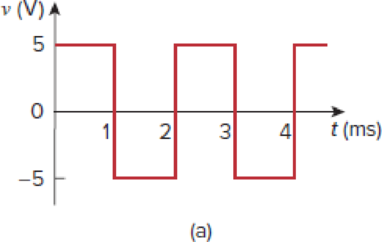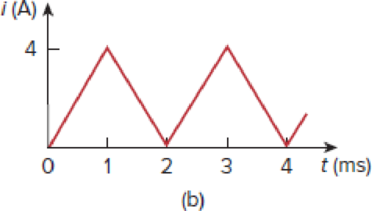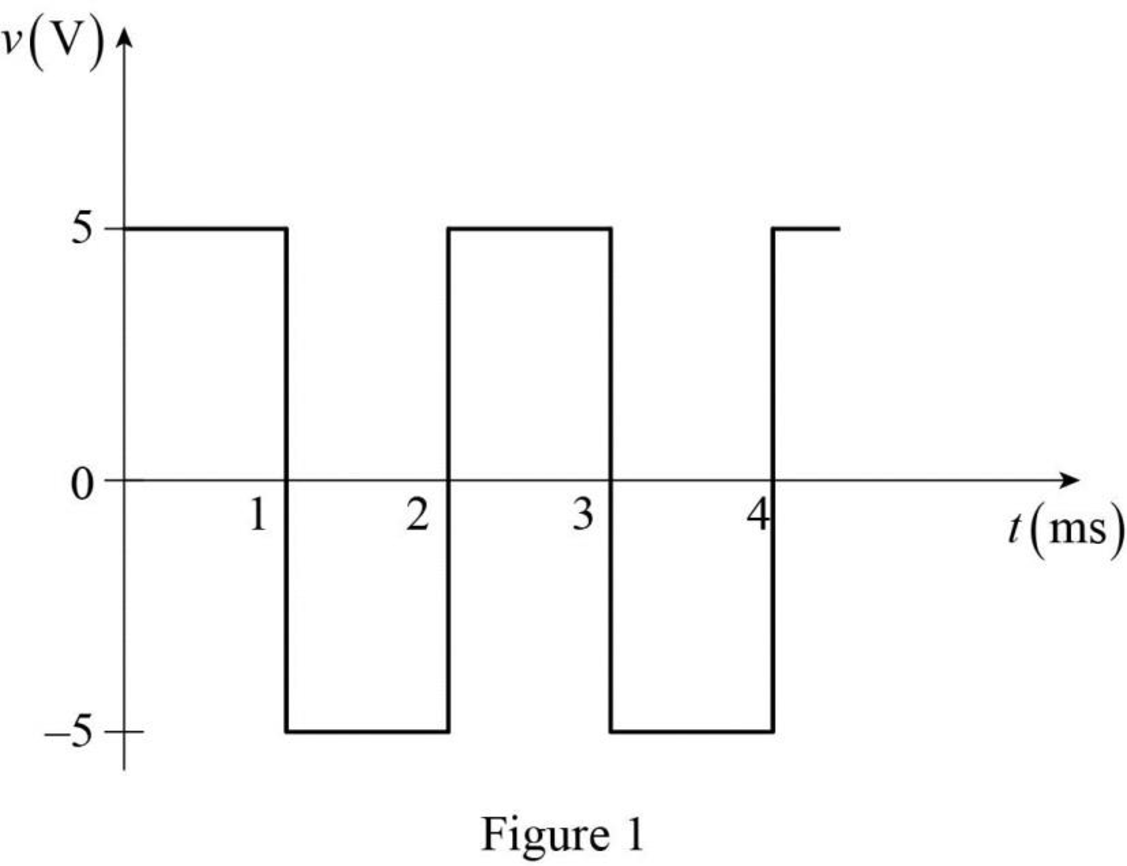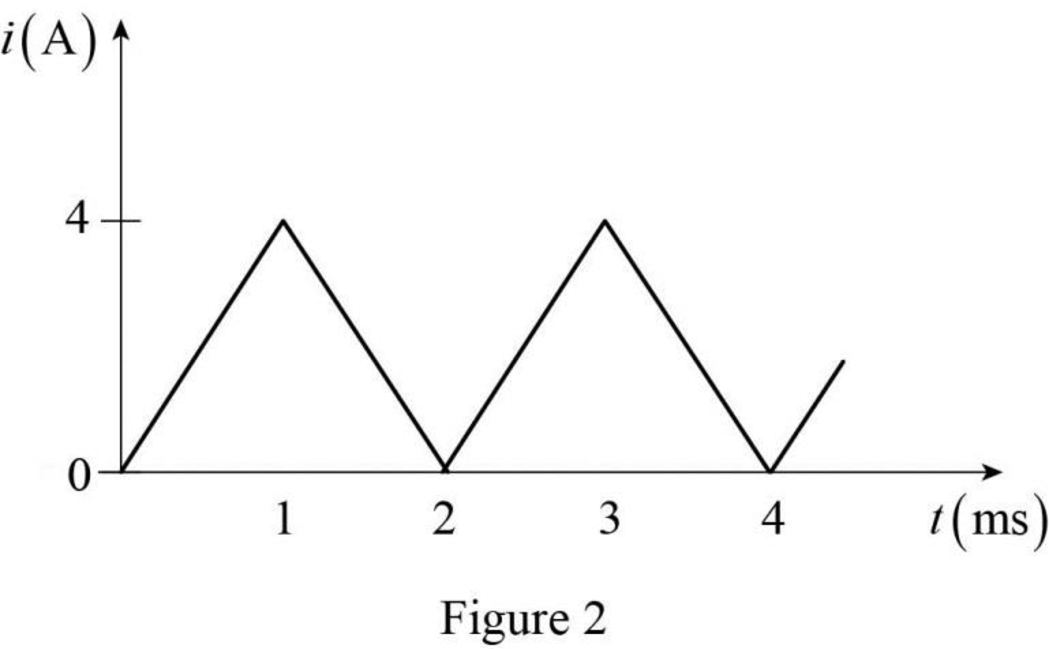
Concept explainers
A square-wave generator produces the voltage waveform shown in Fig. 6.94(a). What kind of a circuit component is needed to convert the voltage waveform to the triangular current waveform shown in Fig. 6.94(b)? Calculate the value of the component, assuming that it is initially uncharged.
Figure 6.94
For Prob. 6.85.


Find the circuit component that is needed to convert the voltage waveform into the triangular current waveform and to calculate the value of the circuit component.
Answer to Problem 85CP
The circuit component inductor is needed to convert the given voltage waveform into the triangular current waveform and the value for the inductor
Explanation of Solution
Given data:
Refer to Figure 6.94 in the textbook.
Formula used:
Write the expression to calculate the straight line equation for two points
Refer to Figure 6.94(b) in the textbook.
From the given graph, substitute
Calculation:
The given voltage waveform is redrawn as Figure 1.

The given triangular current waveform is redrawn as Figure 2.

Refer to Figure 1 and Figure 2. Generally, integration of the square waveform gives the triangular waveform. That is, the integration of the voltage waveform gives the current waveform. Such relation can be obtained in following relation.
Here,
Refer to equation (3), the circuit component inductor is needed to convert the square voltage waveform to the triangular current waveform.
Differentiate the equation (3) with respect to
Rearrange the above equation to find
Refer to Figure 1. The voltage function is expressed as,
Refer to Figure 2, split up the time period as four divisions
Case (i):
The two points
Substitute
Simplify the equation to find
Case (ii):
The two points
Substitute
Simplify the equation to find
Case (iii):
The two points
Substitute
Simplify the equation to find
Case (iv):
The two points
Substitute
Simplify the equation to find
Therefore, the current function of the signal in Figure 2 is,
For
Substitute
For
Substitute
For
Substitute
For
Substitute
Therefore, the voltage function of the Figure 2 is expressed as,
The voltage function of the signal in Figure 1 is equal to the voltage function that is obtained in equation (6).
Compare the equations (5) and (6) for any of the time limits. Assume the comparison is made for
Rearrange the above equation to find
Therefore, the circuit component inductor is needed to convert the given voltage waveform into the triangular current waveform and the value for the inductor
Conclusion:
Thus, the circuit component inductor is needed to convert the given voltage waveform into the triangular current waveform and the value for the inductor
Want to see more full solutions like this?
Chapter 6 Solutions
EE 98: Fundamentals of Electrical Circuits - With Connect Access
- I have uploaded the rules, please explain step by step and which rule you have appliedarrow_forwardUsing the CCS Compiler method to solve this question Write a PIC16F877A program that flash ON the 8-LED's connected to port-B by using two switches connected to port-D (Do & D₁) as shown in figure below, according to the following scenarios: (Hint: Use 500ms delay for each case with 4MHz frequency) 1. When Do=1 then B₁,B3,B7 are ON. 2. When Do 0 then Bo,B2, B4, B5, B6 are ON. 3. When D₁=1 then B4,B,,B6,B7 are ON. 4. When D₁-0 then Bo,B1,B2,B3 are ON.arrow_forwardUse the ramp generator circuit in Fig. B2a to generate the waveform shown in Fig. B2b. Write four equations relating resistors R1, R2, R3, capacitor C and voltages Vs, VR and VA.to the waveform parameters T₁, T, Vcm and Vm- If R = R2 = R3, R₁ = 2R, C = 1 nF, Vcm = 2 V and Vm = 1 V, T₁ = 2 μs and T = 10 μs solve for the values of R, Vs, VR and VA using your equations from part a(i). VR C +VA R3 V₂ Vo мат R1 VsO+ V₁ R₂ Figure B2a Vout Vcm+Vm Vcm Vcm-Vm 0 T₁ T 2T time Figure B2barrow_forward
- The circuit in Figure B1a is a common analogue circuit block. Explain why you would need such a circuit. Draw another circuit in which you use the current flowing in this loop to bias a common source amplifier. This circuit is not ideal for standard CMOS technologies due to threshold shift. Why? Draw an improved version of this circuit to make it better. VDD (W)P MA M3. (), REF (쁜)~ M₁ M2 lout 시~ Rsarrow_forward23bcarrow_forwardDraw the small-signal equivalent circuit of a single transistor amplifier given in figure B1b. Assume the current source to be ideal. Determine the Open-loop transfer function, pole frequency and gain-bandwidth product all in terms of transistor parameters 9m, To and CL. If the load capacitance is 1pF and the necessary unity gain frequency is 600MHz, find the gm for this transistor. V₁ V₁ CLarrow_forward
 Delmar's Standard Textbook Of ElectricityElectrical EngineeringISBN:9781337900348Author:Stephen L. HermanPublisher:Cengage Learning
Delmar's Standard Textbook Of ElectricityElectrical EngineeringISBN:9781337900348Author:Stephen L. HermanPublisher:Cengage Learning
